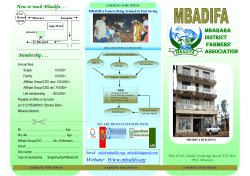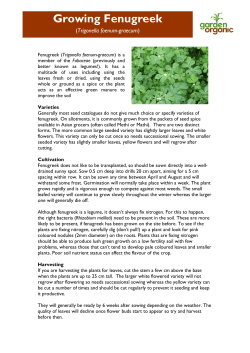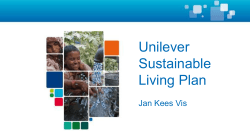
Jottings HOW TO FEED THE WORLD A publication of 2014
Jottings 2014 A publication of HOW TO FEED THE WORLD Heading the list of influences, both globally and locally, are trade rules and regulations that affect both local and global food production and access. Since small-scale family farmers are actually feeding the overwhelming majority of us on this planet – up to 70% in fact – it’s important to consider their critical contributions when developing the rules and policies about how we grow and sell the food they produce. An equally important issue to think about is the way the food is grown. If the family farm is to have a future on this planet, as it must, the ability of smaller scale farmers to stay on their lands is intimately linked to the fertility of the soils they manage and the adaptive capacity of their crops. This edition of Jottings focuses on the sustainability of the farming systems that grow our food. It features concise articles about USC Canada-supported farmers in Asia, Africa, Latin America, and Canada who have chosen an ecologically sustainable and diversitybased approach to seed and food Jottings - A publication of USC Canada Photo: Jim Richardson “How do we feed the world?” is a huge question, one that seems extremely complex since there are so many factors that affect who gets to eat, how much they eat, and how nutritious the food is. production, often called agroecology. Their combination of long-standing and new innovative practices and their attention to the interconnectedness of all the natural resources on their landscapes are proving the smartest and most effective way to feed the world in an age of climate change that for some amounts to climate chaos. Chala Chaka harvests teff from his half hectare field near Bato Chrecha, Ethiopia. on sustainable agriculture subtitled: Wake Up Before It’s Too Late (http://bit.ly/unctad-2013). And of course, please read on. Susie Walsh, Executive Director Don’t just take our word for it. Read the latest UN Trade and Development report SAVE THE CENTREFOLD FROM THIS ISSUE AND KEEP IT HANDY. IT HIGHLIGHTS THE WORLD’S 12 MAJOR CENTRES OF AGRICULTURAL DIVERSITY, AND IT’S A GREAT REMINDER TO VISIT SEEDMAP.ORG, OUR NEW ONLINE PORTAL ON SEEDS, BIODIVERSITY AND FOOD! BUILDING RESILIENCE IN A CLIMATE OF UNCERTAINTY West Africa Photo: Sarah Dalle Photo: Laurent Viot By Laurent Viot, Director International Programs Farmers harvesting millet despite the scorching 40°C temperatures near Djibo, Burkina Faso. It’s difficult to imagine more challenging climate and soils than you find in the West African Sahel. Most farmers depend on rainfall to provide moisture for their crops and degraded soils. This region of the Sahelian belt records around 550mm of rain per year (about half the annual rainfall in Ontario), all falling in just over one month around September. As well, in recent years, farmers have noted irregular and unpredictable rain patterns which are affecting seed germination and yields. In 2012, the UN Food and Agricultural Organization (FAO) reported that 10.2 million people from the Sahel region were food and nutrition insecure and extremely vulnerable to external shocks. My first travel as USC Canada’s new Director of International Programs last October was to visit our programs in Burkina Faso and Mali, with USC Canada’s West Africa Program Manager, Sylvie Perras. At that time, Mali was still very much in the news due to armed conflict and foreign intervention. The population seemed very anxious as soon they would 2 The West African Sahel is one of the world’s most challenging landscapes on which to grow food. be left to face old and new challenges on their own. Malian refugees have also crossed the border into northern Burkina Faso putting additional stresses on local resources and food supplies there. Yet despite climate and conflict challenges, local producers that USC Canada supports are recording amazing harvests reaching up to 2 tons/hectare. To Canadians, these yields may seem very modest but in the Sahel, with its increasingly extreme growing conditions, it remains an incredible feat. Farmers in both Mali and Burkina Faso are acutely aware of their environments and many have been quick to find innovative ways to work with their landscapes – including the use of some new technologies. When we were in Djibo in northeast Burkina Faso, we noted some farmers both gazing at the horizon and checking text messages on their mobile phones. Earlier, there were reports it had rained a few villages away, but the skies were telling a different story. Indeed, there was no rain for Djibo that night. Farmers in the Sahel have long developed their own coping mechanisms and early warning systems to adapt to their harsh environment. USC Canada’s role is to support community efforts to build and increase resilience in this challenging environment. One critical element of USC Canada’s programs in Mali and Burkina Faso is to spread the risk of crop failure by greatly diversifying the varieties planted. To this effect, USC Canada puts biodiversity at the heart of its work promoting both germ banks (conservation of diversity) and seed banks (multiplication and dissemination of locally adapted seed varieties). With each season, saving and sharing seeds of the hardiest varieties of millet, bean, and sorghum offers farmers an increased number of planting choices. Keeping up with dramatic and unexpected weather patterns is daunting, but this strategy has been paying off. For instance, in Burkina Faso, USC Canada’s Jottings - A publication of USC Canada local partner APN Sahel has been recording growing successes that include an increase of crops and varieties planted in and around Djibo as well as a reduction of the lean period among farmer members. Photo: Eileen Jones In Mali, seed resilience strategies have also proved effective amid political upheaval. Amazingly, the farmers who we met felt that the conflict had a limited impact on their farming. Farmer networks and seed bank resources, well established in our program communities, have enabled planting, harvesting, and adaptation to continue. Certainly, farmers acknowledged a serious impact on their livelihoods by isolation and constraints imposed on their movements, preventing trade at local markets. However, despite their isolation, farmers’ groups kept meeting and exchanging seeds, and they even managed to report program progress. Farmers have continued to nurture their networks despite Mali’s political instability. The lesson here is of community resilience. It shows how far good ideas and quality initiatives can go when owned and promoted by its members. It also illustrates how strong foundations of resilience, rooted in agricultural biodiversity, will continue to be a valuable defence for these farming communities in times of both political instability and the rising tide of climate extremes. Fako Coulibaly, Safo village, Mali: Fako has always kept seeds for re-planting season after season but stocks fell short in the 1976-77 drought and he was compelled to purchase new Fako Coulibaly millet seed varieties from Bamako, even though he was unsure about the actual adaptability of these new seeds. They turned out to be a short variety that matured early in August. Fako lost all his harvest to the birds that year. It was an important and costly lesson. Since 2008 he has procured his seeds from known sources at the Safo community seed bank. The CSB offers him a guarantee on quality and known performance adapted to his local conditions, as well as a platform for learning and exchange. January 2014 Photo: Laurent Viot Photo: Laurent Viot LESSONS IN RESILIENCE Abdoulaye Tamboura, Fili-fili village, Burkina Faso: Abdoulaye has been participating in APN-Sahel supported land Abdoulaye Tamboura rehabilitation program. He and his son have been using techniques such as organic compost, reforestation, as well as planting Andropogon gayanus, a native, fast-growing grass to mitigate soil erosion in the harsh arid conditions here. As with others in this program, Abdoulaye’s efforts have paid off. His yearly grain production of millet, sorghum, and corn has showed a 25% increase. 3 CERTIFIED ORGANIC, THE BOLIVIAN WAY Bolivia By Dana Stefov, Program Manager for Latin America Photo: PRODII is known as a “Participatory Guarantee System”. It enables the direct participation of producers and consumers in defining standards, procedures for certification, and decision-making – and it has great potential to improve livelihoods and agroecological farming practices. Demetrio Tola and Reyna Hinojosa, promoters and guardians of agrobiodiversity, harvesting potatoes in Jurinsaya Grande, Bolivia. To become a certified organic farmer in Canada can take years of onerous testing and paperwork, not to mention the hard field work of ridding soils of chemical pesticide and fertilizer residues. And yet, as we all know, every year there is increasing demand for food that is grown naturally, without an industrial load of pesticides or herbicides. With organic certification comes higher value – and better prices for the farmers who grow food this way, as well as strong ecological and environmental standards that will effectively protect priceless natural resources of soils and seeds. speeding up a process that can take about six years, but also for building an alternative model that works for farmers and the environment. Participating farmers can earn two different seals of certification from the national government, one for “in transition” and the second for “ecological production.” Both these seals are a legally recognized guarantee that products have met certain ecological standards. For farmers, it is a valuable ecological seal of approval that also provides better prices and a growing market within Bolivia. This is what There are actually dozens of systems like these around the world, largely being used by agroecological producers and their associations. Primary among their values are participation, transparency, conservation, and ecological agriculture, but they also support community building, environmental stewardship, and strong local economies. The agroecological movement, with significant momentum in Latin America, has been a pioneer of participatory certification programs. In Bolivia, the process is still nascent but the signs are promising. The Ecological Producers Forum of Potosí, organized by PRODII, brings farmers together for learning, policy advocacy and celebrating farmer efforts. At the 2012 event, 50 farmers from the Participatory Guarantee System program in Chayanta received their organic certification – an astonishing number for these early days. There is an even larger list of winners in this process: biodiversity and the environment, local markets and communities, consumers and, most significantly, the farming families of Potosi. Our Bolivian colleagues (PRODII) have been promoting an innovative participatory certification system in the Potosi region that works with Bolivia’s national organic certification Law 3525 and its requirements. It is getting national attention for not only 4 Photo: PRODII Is there any way to encourage and reward farmers who are working toward this standard but cannot yet receive the relative compensation for their work and their produce? In a word, yes. At local markets, farmers like Celia Molina Condori (brown hat) and her daughter Marina Choque Molina (selling) are able to label their product ecological as a result of certification. Jottings - A publication of USC Canada Photo: PRODII Nicolás Yucra Gomez, surrounded by a species of lupin grown for its edible bean. He will use it as a green manure to help improve his soil. Nicolás Yucra Gomez, is a farmer in the municipality of Chayanta in Potosi, Bolivia. With the support of PRODII he and 95 participating farmers from his community have driven the certification of their crops as ecological products. Says Nicholas, “In order to do this, we have been trained in Law 3525, and we convened an Internal Ecological Production Committee (CIPE) with farmers from across our community. Others didn’t believe this would be successful, but after a year of hard work, the Servicio Nacional de Sanidad Agropecuaria e Inocuidad Alimentaria, (like Canada’s Food Inspection Agency) has given us our certificates. With this system, we now control our own ecological production. It is a guarantee between us farmers. Now we sell our produce at the Ecofair of Llallagua, displaying the certifícate. IMPACTS OF PARTICIPATORY GUARANTEE SYSTEMS: • Improved natural resource base, stewardship of agroecosystems and suitable technologies • Direct and local marketing that reduces or eliminates “middle-men” and improves collective bargaining • Enhanced knowledge of locally and ecologically appropriate farming practices and reciprocal learning processes • Value added • Reduced costs of production due to reduced inputs • Participatory and farmer-led, including research relevant to local needs • Strengthened farmer networks and trust Photo: PRODII • Price premiums by labelling products “ecological” or “organic” • More direct links between producers and consumers Nicolas Yucra proudly displaying his certification. Nicolás proudly displaying his certification. January 2014 5 WHERE DOES OUR F NORTH AMERICAN CENTRE CROPS: Jerusalem artichoke, sunflower, plum, raspberry, strawberry, highbush blueberry, cranberry and pecan. FARMERS HAVE CREATED AND MAINTAINED THE KNOWLEDGE AND DIVERSITY THAT IS THE BASIS OF THE PLANET’S FOOD SUPPLY FOR THOUSANDS OF YEARS… AND COUNTING. MOST OF THIS DIVERSITY IS IN THE GLOBAL SOUTH WHERE IT IS INCREASINGLY THREATENED. THE WAY TO SAFEGUARD OUR FOOD SUPPLY IS BY USING AND CONTINUING TO ADAPT THE PLANT AND GENETIC DIVERSITY CAREFULLY BRED AND NURTURED BY FARMERS. LIVESTOCK: Turkey and duck. MESO-AMERICAN CENTRE CROPS: Maize, common bean, Cucurbita (including squash), chili pepper, amaranth, Chenopodium (a relative of quinoa), cacao, tobacco, sisal hemp and upland cotton. SOUTH AMERICAN/ ANDEAN CENTRE CROPS: Andean and common potatoes, sweet potatoes, tomatoes, lima beans, cacao, açaí, brazil nut, cassava, cocona, malanga, guarana and pineapple. GLOBAL CENTRES OF DIVERSITY LIVESTOCK: Llama, alpaca and guinea pig. Virtually all of the foods we eat – our major crops and most livestock species – have their origins in the tropics and subtropics of Africa, Asia, Latin America and Oceania. Scientists have identified at least twelve major geographic “centres of diversity” – regions, or hotspots, that harbor a disproportionately high percentage of all plant, livestock, and cultural diversity. Centres of diversity refer to 1) regions where crops and livestock were originally domesticated from their wild ancestors (regions of true origin) and 2) regions of subsequent spread where they are continually evolving a diversity of new varieties and traits through ongoing adaptation to their environment and selection by farmers. That’s why a specific crop can be listed in more than one centre of diversity. The hotspots on the map capture only a fraction of the vast diversity farmers have been fostering. 6 OUR FOOD DIVERSITY IS UNDER TH Jottings - A publication of USC Canada FOOD COME FROM? EURO-SIBERIAN CENTRE CROPS: Many forage and grasses, spelt wheat, horseradish, turnip, parsnip, plum, pear, apple, cherry and apricot. LIVESTOCK: Pig and reindeer. MEDITERRANEAN CENTRE CENTRAL ASIAN CENTRE CROPS: Oat, pea, fava bean, lettuce, beet, turnip, radish, celery, rhubarb, olive, grape, cumin, thyme and flax. LIVESTOCK: Pig and rabbit. CROPS: Wheat (common, club and shot), rye, onion, garlic, pea, lentil, spinach, beet, carrot and mustard. MIDDLE EASTERN CENTRE CROPS: Millet, buckwheat, soybean, citrus fruits, cherry, leafy mustard and tea. LIVESTOCK: Red jungle fowl, chicken, pig, silkworm and yak. LIVESTOCK: Sheep and pig. CROPS: Wheat (einkorn, durum, poulard), barley, rye, chickpea, grape, pistachio and almond. LIVESTOCK: Goat, water buffalo, cattle and camel. SINO-JAPANESE CENTRE HINDUSTANI CENTRE CROPS: Rice, pigeonpea, eggplant, okra, cucumber, yam, banana, mango, ginger, turmeric, cardamom, sugarcane and black pepper. LIVESTOCK: Wild red jungle fowl, water buffalo, cattle, sheep and goat. AFRICAN/ETHOPIAN CENTRE CROPS: Sorghum, pearl millet, teff, sesame, coffee, african rice, baobab, oil palm, cowpea, guinea yam, okra, scarlett eggplant and shea. LIVESTOCK: Donkey and cattle. SOUTHEAST ASIAN CENTRE CROPS: Rice, yam, squash, mango, banana, durian, lime, bamboo, nutmeg, clove and coconut. LIVESTOCK: Chicken, cattle and pig. AUSTRALIAN CENTRE CROPS: Eucalyptus, acacia and macadamia nut. HREAT. January 2014 LEARN MORE ABOUT THE SOLUTIONS. FIND OUT MORE: WWW.SEEDMAP.ORG SeedMap.org is an online portal on seeds, biodiversity, and food that lets you visit hundreds of case studies around the world. To download a print version of this map: www.seedmap.org 7 CANADIAN SEED PROGRAM: A NEPALI REVIEW By Pratap Shrestha, Asia Regional Representative and Scientific Advisor Photo: Kate Green Pratap Shrestha – our Asia Regional Representative and Scientific Advisor based in Nepal – visited Canada in September to check out our Canadian program, the Bauta Family Initiative on Canadian Seed Security. He visited three partners: Loïc and Thomas Déwavrin’s farm in Quebec and, in Ontario, Kim Delaney’s Hawthorn Farm and Cory Eichman’s Saugeen River Farm. He left us with these excellent insights. Pratap with Thomas Déwavrin at his family farm in Quebec. Adding Value It was quite revealing to see how organic farming can be built into the commercial agricultural system – especially through the use of biomass as fertilizer through planting of “green manure” crops. The sustained soil fertility results in very respectable maize and soybean yields. Innovative marketing approaches are clearly important to build economic incentives to organic farming in Canada. I found the CSA (Community Supported Agriculture) model - direct supply to the consumers – particularly impressive. I also like the way product transformation could be linked to direct sales. Photo: Kate Green Thomas Déwavrin inspects a bottle of sunflower oil produced at his farm. Late harvest tomatoes at Saugeen River farm. 8 Farmers Innovation Farmers’ innovation was another key element that I observed at the three farms I visited. The Quebec farmers I met, Loïc and Thomas Déwavrin were processing their wheat and sunflowers into flour and oil that then goes directly to consumers and restaurants. This seemed a very important strategy to reduce the market Photo: Pratap Shrestha Another interesting observation was that organic farming is possible without integrating livestock in the system, quite contrary to the Nepal situation. Increasing biomass with green manure is the key. Luckily, you have enough land here to be able to rotate the field with the green manure crops. That is not the case in Nepal. margin that the middlemen often get. The farmer secures a bigger profit margin. This strategy is also helpful in demonstrating the different value systems within organic farming. Photo: Pratap Shrestha Organic Farming is Feasible Kim Delaney demonstrates a homemade seed cleaner powered by a shop vac. Jottings - A publication of USC Canada It was quite revealing to see how farmers save seeds of hundreds of varieties. Kim has saved more than 200 varieties of crops like beans, greens, tomatoes, grasses, herbs, squashes; the Déwavrin brothers grow more than 5 varieties of maize, three varieties of soybean and similarly larger varieties of other crops. And Cory too saves all kinds of vegetable seed varieties. Farmers like these are truly the real custodians of biodiversity. Photo: Pratap Shrestha It was interesting to see how these smallerscale family farms depend on family support and traditions; brothers farming as a family business, bringing different skills such as at Loïc’s farm; Kim’s mother helping her to process some seeds; and the use of student interns at Cory’s farm. This whole system of producing good healthy food is where agri meets culture (agri+culture) and is not just following the mechanics of producing industrial food. USC’s Kate Green and Pratap with Kim and Aaron at Hawthorn Farm Still it strikes me that these farmers are left on their own without much research and development (R&D) funding. Ironically, they’re like a “neglected and underutilized species” (NUS) that we talk about in this ecological agriculture work. Even so, just like the NUS crops, they are doing well in the changing social climate and shining a light on the future of farming. January 2014 Photo: Kate Green Family Farming At Hawthorn Farm, Pratap and Kim survey her seed collection. We owe them thanks, from the bottom of our hearts, for their valuable contribution to the conservation and sustainable use of agricultural biodiversity. This on farm or “in situ” conservation of our planet’s plant genetic diversity is of a huge national and global importance. Growing such a large variety of crops and making them available to other farmers is simply great practice. The Bauta Initiative is very timely. Appreciating and supporting the work of these farmers is long overdue. Farmers breeding Farmers have always been breeding new crops and varieties, fewer in modern days, especially within the West industrial agriculture system. In countries like Nepal, on the other hand, the breeding of local, adapted varieties is still happening on many small holder farms. The visits to these comparatively small scale Canadian farms were quite revealing for me. It was so encouraging to see farmers keeping the interest and tradition of breeding alive. Photo: Pratap Shrestha Commitment to Conservation Cory Eichman at Saugeen River Farm has been breeding tomato varieties. Through careful selection, the Déwavrin farm saves their own seeds to plant the following year. Kim’s work in maintaining such a huge diversity of vegetables through careful isolation distances and meticulous seed selection leaves me speechless. And what to say about Cory breeding his own tomato varieties! Everdale Seed Bank My last stop was to Everdale Farm and Environmental Learning Centre. Their seed bank is great in saving and maintaining diversity and also giving easy access to farmers and gardeners. The seed bank connects community, farmers, and the National Gene Bank; practices that would be good to share with our global country programs. Photo: Pratap Shrestha A few of the most interesting innovations include: seed processing and storage (use of natural cold air); a wheat flour machine and sunflower cold oil press at the Déwavrin farm; seed blower for seed processing and a unique trailer for bean vines at Kim’s; and the use of horse-drawn machines at Cory’s farm. It’s astounding to see how tools and knowledge that were rapidly dying are being brought back into use, and that farmers are going to great lengths, getting them from as far away as France. I salute farmers who are keeping the tradition alive. Variety is everywhere at Everdale. Before I end, I would like to extend my sincere thanks to Thomas, Loïc, Kim, and Cory for their valuable time and insights. And what an amazing meal at Everdale – most of it coming fresh from the farm! Best regards, Pratap 9 INNOVATION ON STILTS Timor Leste Photo: Pratap Shrestha By Kate Green, Program Manager for Asia USC Canada’s operation in Timor Leste, Asia’s youngest country, has recently become a Timorese NGO, RAEBIA (Resilient Agriculture and Economy for Biodiversity Action). USC Canada is delighted to continue to support their excellent work. The da Cunha family has turned farming on a steep and stony slope into an agroecology based productive powerhouse. Readily embracing innovation, they are getting support from our partner, RAEBIA, to try out new ideas. Seedlings on Stilts: Above, Aquelino da Cunha, with two of his children, tested the stilts that delivered excellent results for his fields (below). Insects, rain, and a very humid environment all year long are tough challenges when trying to raise vegetable seedlings to a healthy and robust stage, ready for transplanting. Aquelino da Cunha is very pleased with their latest new idea, a ‘stilted seedling nursery.’ In this way, the maximum number of seedlings is reaching the transplant stage. 10 Photo: Pratap Shrestha These simple, raised, waist-high seedling beds have made a huge difference. The shade and rain cover allow for air flow to reduce disease and infestations, and the stilts discourage other pests and provide drainage to reduce water logging. Jottings - A publication of USC Canada SPREADING SEEDS… AND EMPOWERMENT Bangladesh Photo: Hosneara Khondker By Hosneara Khondker, Bangladesh Country Representative, and Kate Green, Program Manager for Asia Girls dry seeds in the hot Bangladesh sun for storing at an ARC seed bank One of the most striking things about Bangladesh is the lushness – and the humidity. In the photo above, young women from the Matrivumi Adolescent Resource Centre Community Seed Bank are demonstrating an innovative and effective way to work with the Bangladeshi ecosystem. When the sun is strongest, they put their valuable seed samples out in the sunshine to keep them dry! And what an extraordinary range of seeds – close to 50 vegetables (beans, tomatoes, cabbages, mustards, cauliflowers, and onions among them) with up to 5 varieties of many. Young women in rural Bangladesh are a most vulnerable group, with little access to earning income either before or after marriage. However, garden space is something virtually all of them can gain access to from parents or in-laws. Harder to come by is access to information about (1) how to grow superior vegetables, (2) market their produce, or (3) become a highly valued seed provider in their community. That’s where USC Canada’s support of young women is unique. The Adolescent Resource Centres (ARCs) are a network of 16 simple, small buildings hosted by local community organizations which provide a variety of services to adolescent girls and young women from 50 villages in the January 2014 northwest of Bangladesh. The first ARCs were established about 6 years ago to provide a focal point for health, education, legal services, and have now added agricultural skills training for young women. Many local groups provide services here, but USC Canada’s focus is unique in that it is helping young women start organic vegetable gardens, run effective market vegetable businesses, and very importantly, manage community seed banks in the ARCs. The seed bank is a great community resource and a foundation for agroecology in the challenging and rural communities of the northern part of the country where USC Canada works. The community seed banks (CSBs) and the Adolescent Resource Centres that house these seed banks also provide seed-saving and ecological agricultural systems training. The ARCs are now hubs for crucial food and seed security components and provide ecological agricultural training workshops for over 1000 young women each year. Most importantly, the practice of seed saving is being widely instilled in the community through these community seed banks, and through the many young women who are now seen as valuable stewards of these precious resources. 11 NOT JUST ANOTHER DAY AT THE OFFICE Ethiopia By Martin Settle, Director of Finance and Human Resources Photo: Sarah Dalle And so we have this extraordinary field. This is the Harbu CSB Seed Multiplication Field, where those small vials of seeds will be grown out – multiplied by thousands – to meet the demands of the farmers. Martin joins local farmers and EOSA field staff near Harbu, in South Wollo, Ethiopia. On a typical day, I can be found sitting at my desk at 56 Sparks Street, reviewing accounts or discussing budgets. This is the typical life of a Finance Director. Part of my role at USC Canada, however, is to support our overseas partners in ensuring that our funds are used effectively. This requires that I periodically visit our partners. So it was that last September I found myself standing in a field near Harbu, Ethiopia. This was no ordinary field. The quarter hectare was divided into 10 small plots. Five varieties of durum wheat, two varieties each of mung bean and pearl millet, and a single teff were all at various stages of growth. Each had been selected by local farmers through a process called Participatory Varietal Selection (PVS). In the PVS process, many – sometimes dozens – of varieties of a particular crop are planted close together in very small plots. Through several seasons the farmers evaluate each variety against their own needs, and select a few they would like to grow themselves. For the Community Seed Bank (CSB), this presents a challenge – how to turn the small handful of seeds in the germplasm storage into a supply large enough to provide for the many farmers anxious to plant them. Multiplication: it sounds like math, but as this is no ordinary field, this is no ordinary math. This is the math of the miraculous. It’s the math by which those precious packages of seeds – collected in the conviction that by their existence alone they are of value – contribute to the food sovereignty of a community. It’s the math by which a gift of seed by a single farmer, protected and cared for by the community of farmers, becomes the nourishment for generations. Multiplication describes the Ethiopia program. In the past year, both of the USC Canada supported CSBs have built satellite facilities to better serve their remote communities. The work with seeds transforms the social fabric: the CSBs are now hosting self-directed women’s and youth groups which through collective action are benefiting themselves and their community. Beyond Harbu, our partner EOSA (Ethio Organic Seed Action) has been engaged by European agencies and the Ethiopian government to replicate the Seeds of Survival approach in other districts. The benefits compound as the work multiplies. This reminds me of yet another multiplier: each dollar donated to our “Seeds of Survival program is multiplied – by a factor of 4 – by the Government of Canada, enabling this multiplicative work to continue. DONATE TODAY We can’t continue these kinds of successes without your help. Please donate today. Donate online. It’s easy, fast, safe and secure. www.usc-canada.org/donate-now Call our toll-free number: 1-800-565-6872 Mail your cheque to USC Canada, 56 Sparks Street, Suite 705, Ottawa, Ontario K1P 5B1 Under the oversight of a volunteer/international Board of Directors, our ground-breaking Seeds of Survival program is managed by a core staff of 20 professionals in Canada and committed partners in Asia, Latin America, Africa and Canada. Your feedback is important to us. Contact us with your thoughts and opinions about Jottings at jottings@usc-canada.org. Editorial Team: Sheila Petzold, Ron Cross USC Canada 56 Sparks Street, Suite 705 Ottawa, ON K1P 5B1 Tel: 613.234.6827 Toll Free: 800.565.6872 www.usc-canada.org Charity registration No. 11927-6129-RR-0001 USC Canada was founded in 1945 by Dr. Lotta Hitschmanova as the Unitarian Service Committee of Canada.
© Copyright 2025











